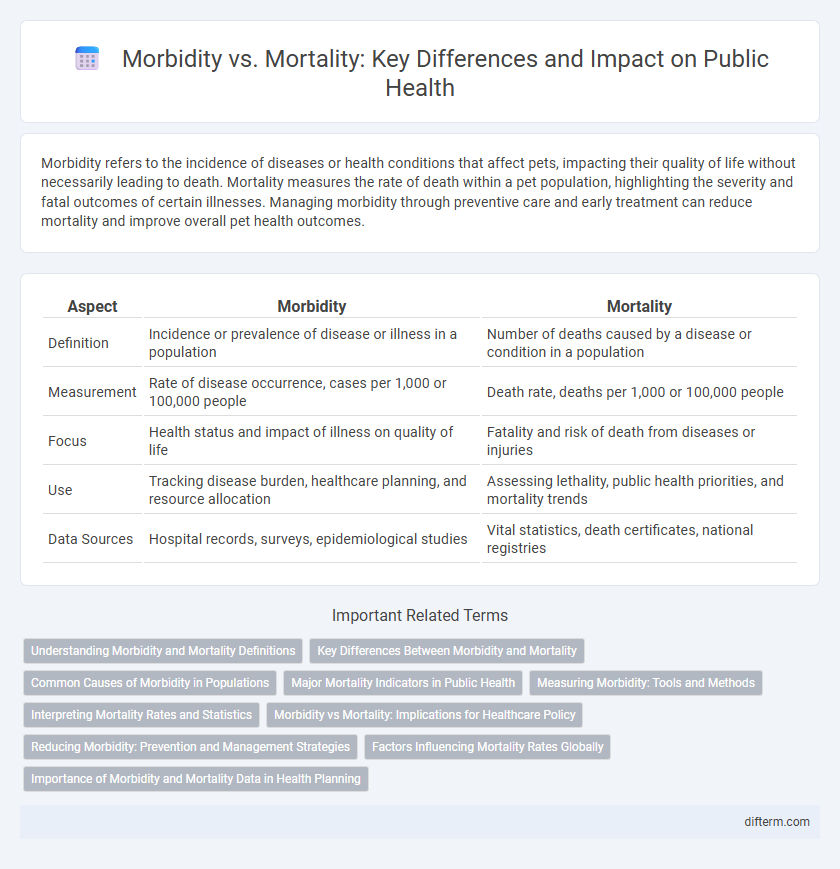Morbidity refers to the incidence of diseases or health conditions that affect pets, impacting their quality of life without necessarily leading to death. Mortality measures the rate of death within a pet population, highlighting the severity and fatal outcomes of certain illnesses. Managing morbidity through preventive care and early treatment can reduce mortality and improve overall pet health outcomes.
Table of Comparison
| Aspect | Morbidity | Mortality |
|---|---|---|
| Definition | Incidence or prevalence of disease or illness in a population | Number of deaths caused by a disease or condition in a population |
| Measurement | Rate of disease occurrence, cases per 1,000 or 100,000 people | Death rate, deaths per 1,000 or 100,000 people |
| Focus | Health status and impact of illness on quality of life | Fatality and risk of death from diseases or injuries |
| Use | Tracking disease burden, healthcare planning, and resource allocation | Assessing lethality, public health priorities, and mortality trends |
| Data Sources | Hospital records, surveys, epidemiological studies | Vital statistics, death certificates, national registries |
Understanding Morbidity and Mortality Definitions
Morbidity refers to the incidence or prevalence of diseases and health conditions within a population, emphasizing non-fatal health impacts and quality of life implications. Mortality measures the frequency of death within a population, often expressed as the mortality rate or death rate per 1,000 or 100,000 individuals. Understanding the distinction between morbidity and mortality is essential for public health strategies aimed at reducing disease burden and improving population health outcomes.
Key Differences Between Morbidity and Mortality
Morbidity refers to the incidence and prevalence of diseases or health conditions within a population, highlighting the frequency and impact of illness. Mortality specifically measures the rate of death, providing crucial data on the number of deaths in a population over a specific period. Understanding the differences between morbidity and mortality is essential for public health planning, resource allocation, and evaluating the effectiveness of medical interventions.
Common Causes of Morbidity in Populations
Chronic diseases such as diabetes, cardiovascular conditions, and respiratory disorders represent the leading causes of morbidity in global populations, significantly impacting quality of life and healthcare resources. Infectious diseases, including influenza and tuberculosis, continue to contribute substantially to morbidity rates, especially in developing regions. Mental health disorders, particularly depression and anxiety, are increasingly recognized as major contributors to global morbidity, affecting functional capacity and social well-being.
Major Mortality Indicators in Public Health
Major mortality indicators in public health include the crude death rate, age-specific mortality rate, infant mortality rate, and maternal mortality ratio, which provide crucial insights into the overall health status of populations. The infant mortality rate measures deaths of infants under one year per 1,000 live births, serving as a key indicator of healthcare quality and socio-economic conditions. Maternal mortality ratio captures deaths related to pregnancy or childbirth per 100,000 live births, reflecting the effectiveness of maternal health services and public health interventions.
Measuring Morbidity: Tools and Methods
Measuring morbidity involves identifying the prevalence and incidence of diseases using tools such as health surveys, medical records, and disease registries. Epidemiological methods like cross-sectional and longitudinal studies provide data on illness patterns and risk factors. Standardized metrics such as Disability-Adjusted Life Years (DALYs) and Quality-Adjusted Life Years (QALYs) quantify the burden of disease and impact on population health.
Interpreting Mortality Rates and Statistics
Mortality rates quantify the frequency of deaths within a specific population and timeframe, serving as critical indicators of public health status. Interpreting these statistics involves assessing age-adjusted mortality rates to account for demographic differences and identifying leading causes of death to target healthcare interventions. Accurate analysis of mortality data supports effective resource allocation and the development of prevention strategies to reduce premature deaths.
Morbidity vs Mortality: Implications for Healthcare Policy
Morbidity refers to the incidence of diseases and health conditions within a population, while mortality measures the rate of death. Healthcare policy must balance strategies targeting morbidity by improving disease prevention, treatment, and management, alongside efforts to reduce mortality through emergency care and chronic disease control. Emphasizing morbidity reduction can lower healthcare costs and enhance quality of life, whereas focusing solely on mortality may overlook broader health system challenges.
Reducing Morbidity: Prevention and Management Strategies
Reducing morbidity involves implementing effective prevention and management strategies such as vaccination programs, lifestyle modifications, and early disease detection through regular screenings. Chronic disease management frameworks emphasize patient education, medication adherence, and rehabilitation to minimize complications and improve quality of life. Targeted interventions in high-risk populations significantly decrease incidence rates and healthcare burden associated with non-communicable diseases.
Factors Influencing Mortality Rates Globally
Mortality rates globally are influenced by factors such as socioeconomic status, access to healthcare, and prevalence of infectious diseases. Environmental conditions, including sanitation and pollution levels, significantly impact death rates, especially in low-income regions. Demographic variables like age distribution and chronic disease burden also play critical roles in shaping mortality trends worldwide.
Importance of Morbidity and Mortality Data in Health Planning
Morbidity and mortality data are essential for effective health planning, providing critical insights into disease prevalence and causes of death that inform resource allocation. Accurate morbidity statistics help identify emerging health trends and prioritize preventive interventions, while mortality data assess the effectiveness of healthcare systems and guide policy development. Combining both datasets enables comprehensive public health strategies to reduce disease burden and improve population health outcomes.
Morbidity vs Mortality Infographic

 difterm.com
difterm.com